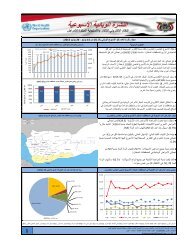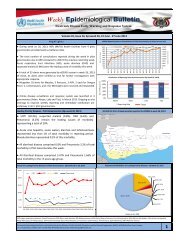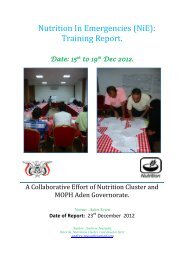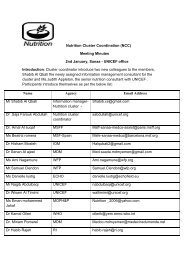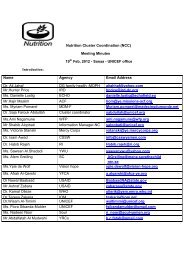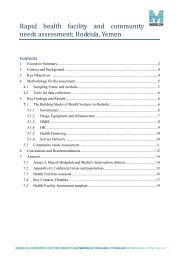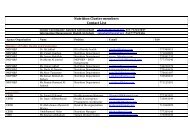Download - Yemen Humanitarian Response | YEMEN
Download - Yemen Humanitarian Response | YEMEN
Download - Yemen Humanitarian Response | YEMEN
Create successful ePaper yourself
Turn your PDF publications into a flip-book with our unique Google optimized e-Paper software.
Table 14b: Percentage of non breast feeding children, 6 to 23 months old, who received theminimum* number of meals, Lahj governorate, July 2012LowlandMountainousEcological Zone% N % NAge Group6-11 17.6 3 7.7 112-17 14.8 4 19 418-23 30.0 12 20 10Total 22.6 19 17.9 15*Minimum defined as 2 times for breastfed infants 6-8 months, 3 times for breastfed infants 9-23 months, 4times for non-breastfed infants 6-23 monthsAmong the children 6 to 23 months of age who were no longer breastfeeding (Table 14b), only22.6% in Lowland and 17.9% in Mountain have received the minimum number of meals fortheir age in the previous day. This finding has serious implications on the lack of maternalknowledge in regards to appropriate child feeding practices. Overall, the finding clearlyindicates a troublesome situation.4.6. Morbidity and Health seeking behavior4.6.1. Child MorbidityHigh prevalence of common childhood diseases was recorded in both the Lowland andMountainous Ecological zones (Table 15). Major diseases were cough, fever and diarrhoearelated, of which ARI and Fever were the most prevalent illness reported in Lowland andMountainous zones, respectively.For diarrhea, there was no important difference among the survey areas. Nearly 29% ofchildren in Mountainous zones had experienced diarrhea in the two weeks prior to the survey,while in the Lowland communities it was approximately 28%. The prevalence of ARI was higheramong the Lowland populations than the lowland populations. Nearly half of children (48.5%)in Lowland had experienced ARI in the two weeks prior to the survey, while in the Mountaincommunities it was approximately one third. The prevalence of Fever was also very high in theLowland population with over 42% of the children under 5 suffering in the two weeks prior tothe survey. The prevalence of Fever in the Mountainous populations was approximately 37%. Itshould be noted that the morbidity data collected are subjective in the sense that they arebased on the mother’s perception of illness without validation by medical personnel.38




